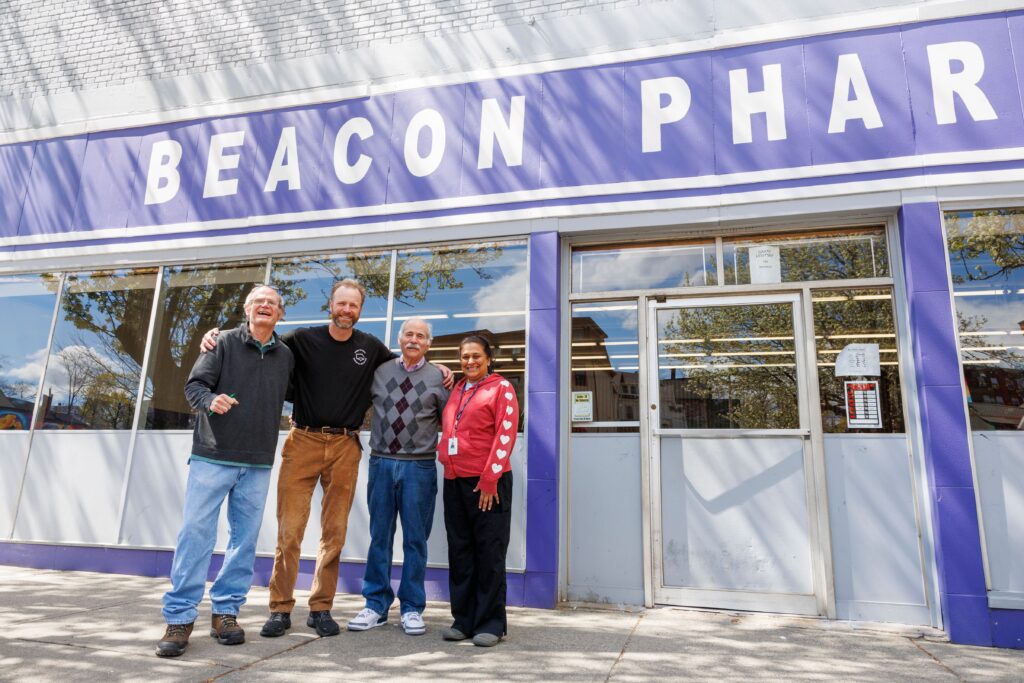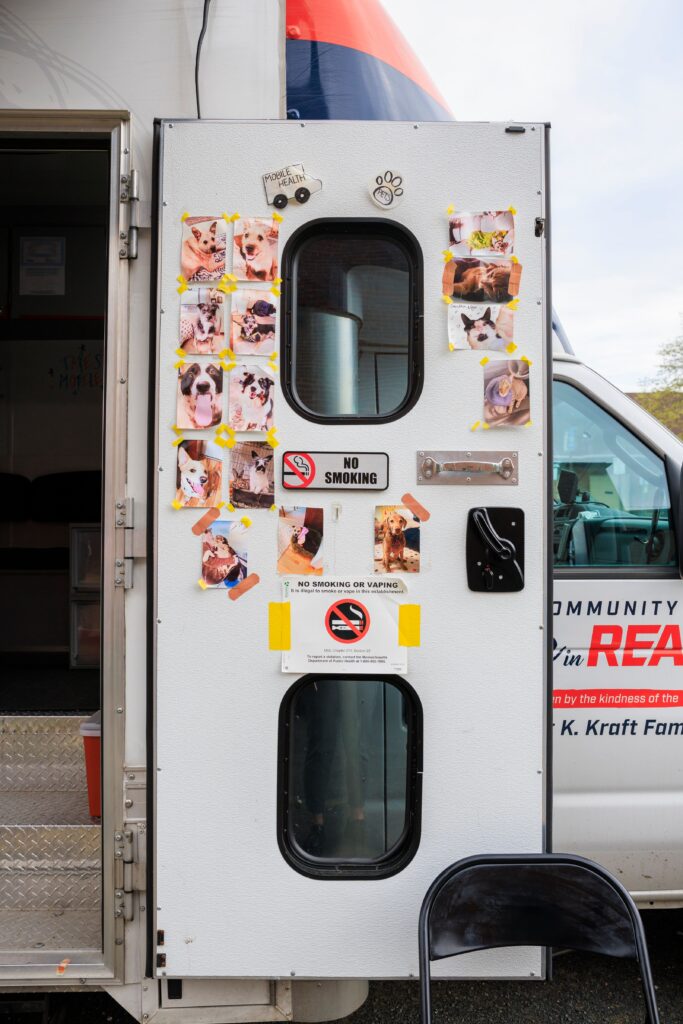Engaging with local stakeholders is crucial to the planning and implementation of a mobile health program. The team should consider reaching out to community partners to:
• Use existing data to demonstrate the need in target areas
– Be mindful to protect patients’ and PWUD’s privacy when presenting data; when possible, use data in the aggregate, highlight data limitations and be sure to contextualize when describing trends.
• Present research supporting interventions which may be controversial, for example, syringe exchange and medications for OUD
• Describe the program design and goals, answer
any questions and address any concerns about the
proposed program.
• Solicit feedback on parking location and observed
drug activity in the area.

• Establish linkages to local partners including health
centers, addiction programming and other support
services and create a plan for seamless referrals to
these services.
– Consider establishing memoranda of understanding
to formalize relationships.
– Ongoing care coordination with community partners
is necessary to navigate complex referral.
– Engagement with local pharmacies is important.
• Establish an ongoing dialogue and provide consistent
updates to community partners during the pilot phase.
Sample list of stakeholders to consider for
community engagement:
– City Hall officials
– City Council representatives
– Neighborhood liaisons
– Law enforcement
– Homeless services/shelters
– Community health center leadership
– Neighborhood coalitions
– Business owners/coalitions
Examples of community concerns and sample responses: Please note that not all potential responses may apply depending on program design or resources
Concern: Diversion—Worries that prescribed treatments such as buprenorphine will be sold on the street or otherwise misuse
Response:
• Mobile health program clinicians will only be
providing short-term prescriptions—rarely more
than a week’s worth of medication.
• Mobile health program clinicians test (like at any
other office-based addiction treatment [OBAT]
program) whether a client is using medication
appropriately—toxicology testing can identify if
a patient is taking the medication—and clinicians
are trained to respond to results appropriately.
• Mobile health program clinicians are from
*Organization X* and are highly trained in substance
use disorder treatment. They have expertise in this
field and in handling the associated challenges.
• Mobile health program clinicians will also use their
electronic medical record system, as well as state
prescription monitoring programs, to ensure clients
are not receiving duplicate prescriptions elsewhere—
the same methods that would be used in a
brick-and-mortar clinic.
• It’s worth thinking about some basic education on Suboxone—and that the illicit market that exists for it is because there is a dearth of MOUD programs and services. People generally seek buprenorphine in order to manage cravings and prevent use of heroin/fentanyl.
• Maybe worth mentioning to stakeholders that the program has and will continue to engage with police and law enforcement and that diversion is always a concern but tox screens aim to prevent diversion.
Concern: Line of people —Worries that the presence of the mobile health program would attract unwanted attention, forming lines in the neighborhood of potential clients
Response:
•The goal of the program is to be a discreet service
with effective and targeted outreach.
• Most outreach would be done on foot—mobile health
program clinicians and outreach team plan to park
the van and interact with potential clients on foot,
only bringing those interested in services back to
the van.
• Mobile health program staff are currently
working with the city and neighborhood stakeholders
to identify parking spaces that are discreet and
would have as minimal as possible an impact on
local businesses.
• The goal of the mobile health program is to ultimately
connect clients to permanent medical homes at local
brick-and-mortar facilities after providing them some
much-needed stability. This type of programming is
meant to serve people not connected to care in areas
of frequent overdose. The goal is not to become a
high-volume program with a large caseload, but to
provide stabilization and connect people to existing
community health programming.
• By connecting people with the services they need,
the hope is that it will help alleviate issues currently
seen on the street
• Opioid agonists, like buprenorphine, reduce overdose, illicit drug use, crime and transmission of infectious diseases.
• Mobile health program staff will continue to liaise with community stakeholders about concerns as they arise.
Concern: Clients from outside of the neighborhood —Worries that most of the “problem” comes from out-of-towners who are drawn into the neighborhood by the city’s or town’s services and the mobile health program will only serve to draw more people in and negatively impact the community
Response:
• There is a clear and visible overdose crisis in the
country and locally, impacting people from all walks
of life. As municipalities work to increase capacity
for addiction treatment, this innovative program
aims to engage individuals at highest risk of death,
decrease the harms associated with drug use and
serve as a portal of entry into addiction treatment.
The mobile program aims to serve people already
in the neighborhood who are at high risk of death.
The program does not plan to advertise broadly,
but rather, the hope is that information about the
program will spread locally by word of mouth. The
hope is that this innovative program will play a role
in achieving this goal.
• During the pilot phase, mobile health program staff
will be collecting data as part of their evaluation
and will hopefully get a better understanding of
where clients are from and how we can help those
communities bolster their efforts to serve those
in need.
• Research shows that harm reduction programming
such as syringe exchange programs does not
increase crime rates.
• In general, PWUD are not likely to travel long distances for addiction services such as a syringe exchange. Research has shown that PWUD are much more likely to use an exchange if they lived within walking distance and most syringe exchange participants already live in the neighborhood.
Concern: Needles —Publicly-discarded syringes are a real issue for many neighborhoods and there are worries that harm reduction services (including SSPs) on the mobile health program van will result in an increase in inappropriately discarded needles
Response:
• Scientific studies have demonstrated the following
about SSPs:
– SSPs reduce infections (including HIV and
Hepatitis C) among people who inject drugs.
– Participants in SSPs are more likely to safely
dispose of their syringes and in areas where SSPs
are implemented and research shows there are
fewer discarded syringes.
– Participants in SSPs are more likely to seek
treatment for substance use disorders.
• Mobile health program staff will be safely disposing
of any syringes they come across during outreach
and regular walking routes.
• *Organization X* runs the SSP for the neighborhood
and is extremely experienced. *Insert any statistics
on syringe collection.*
• Harm reduction services provide multiple options
for disposal and incorporate safe disposal education
regularly when engaging with participants. All
participants are encouraged to return their syringes
and are given personal biohazard containers.
• Mobile health program staff will be communicating
regularly with neighborhood partners during the pilot
to address any concerns, including increased
numbers of inappropriately discarded syringes.
• Mobile health programs may explore opportunities
to stage regular “community clean-ups.”
Note: Harm reduction programs that conduct syringe exchange are frequently asked:
1) why is a 1:1 exchange rate policy not implemented to reduce syringe circulation and
2) why retractable needles are not used in needle exchange programs. In fact, both strategies have been associated with increased rates of infection in PWUD and are therefore not regularly used in SSPs.12, 13
“Why our neighborhood?”—Perception from target neighborhoods that they are being unfairly singled out, when they consider other neighborhoods to have more issues
• Target areas were selected based on a few conditions, including:
– City/town overdose data demonstrated high rates of fatal and non-fatal overdose.
– Neighborhoods were not saturated with current street outreach efforts to those struggling with substance use disorders.
• One of the advantages of being a mobile program would be that if data demonstrate urgency in another neighborhood or demands for services are lacking in the current target areas, the mobile program can adjust accordingly.

7 Marx MA, Crape B, Brookmeyer RS, Junge B, Latkin C, Vlahov D, Strathdee SA. 2000. Trends in crime and the introduction of a needle exchange program. American Journal of Public Health 90(12): 1933–1936
8 Rockwell R, Des Jarlais DC, Friedman SR, Perlis TE, Paone D. 1999. Geographic proximity, policy and utilization of syringe exchange programs. AIDS Care 11(4): 437-442.
9 Aspinall, E et al, 2014. Are needle and syringe programmes associated with a reduction in HIV transmission among people who inject drugs: a systematic review and meta-analysis. International Journal of Epidemiology, 43(1), pp.235-248
10 M.C. Doherty, B. Junge, P. Rathouz, R.S. Garfein, E. Riley and D. Vlahov, “The Effect of a Needle Exchange Program on Numbers of Discarded Needles: A 2-Year Follow-Up,” American Journal of Public Health, vol. 90 (2000), p. 936
11 Hagan, H., McGough, J.P., Thiede, H., Hopkins, S., Duchin, J. and Alexander, E.R., 2000. Reduced injection frequency and increased entry and retention in drug treatment associated with needle-exchange participation in Seattle drug injectors. Journal of Substance Abuse Treatment, 19(3), pp.247-252.